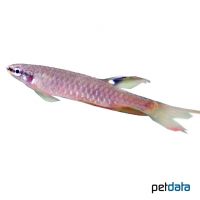Splash Tetra (Copella arnoldi)
| Splash Tetra Copella arnoldi | |
|---|---|
| Name | Splash Tetra |
| Name Lat. | Copella arnoldi |
| Synonym | Copeina arnoldi |
| Family | Pencilfishes |
| Family lat. | Lebiasinidae |
| Order | Characins |
| Order lat. | Characiformes |
| Origin | South America |
| Habitat | Streams, ponds |
| Diet | Carnivore |
| pH | 4.0-7.5 |
| Behavior | Peaceful |
| Keeping | Group |
| Care Level | Moderate |
| Reproduction | Substrate spawner |
| Breeding | Moderately difficult |
| Life Span | 3-5 years |
| Protection | No |
| Metric Units | |
| Size | 5-8 cm |
| Temperature | 23-28 °C |
| Hardness | 1-8 °dH |
| Aquarium | ~ 110 l |
| US Units | |
| Size | 2"-3" |
| Temperature | 73-82 °F |
| Hardness | 18-142 ppm |
| Aquarium | ~ 30 gal |
Distribution and habitat
Splash tetras are widespread in the lower Amazon River basin in Brazil as well as in the Guyana countries. They live in slow-flowing, small rivers and forest streams as well as in stagnant waters such as ponds and floodplains with dense, overhanging riparian vegetation.
Maintenance
The aquarium should have soft, slightly acidic water and varied planting that provides both shelter and swimming space. A dark substrate covered with some foliage (e.g. sea almond leaves), some roots and shaded light (floating plant cover) is ideal.
No ammonia, ammonium and nitrite should be detectable, the nitrate value should not exceed 100 mg/l. To ensure the water quality and oxygen content, a filter and heater adapted to the aquarium size is required, as well as lighting for the species-appropriate day-night rhythm of the animals.
Diet
In the wild they feed mainly on worms, insects and small crustaceans. The food supply consists of live food, such as cyclops, daphnia, artemia and mosquito larvae, which are also well accepted frozen, plus commercially available frozen special food mixtures. High-quality, protein-rich dry food (flakes, granules) is also usually accepted without problems.
A regular and varied diet promotes health and prevents deficiency symptoms. Only as much should be fed as is eaten immediately (in a maximum of 10 minutes).
Behaviour and compatibility
They are very peaceful schooling fish that can easily be socialized with other small and peaceful fish. At least 5, but preferably more Spritzsalmler should be kept together.
Basically, only mutually compatible fish species with similar requirements for water conditions and water temperature should be socialized.
Sex dimorphism
Males are lighter colored and larger than females. Adult males have longer extended fins.
Reproduction and breeding
Splash tetras owe their name to their unusual reproductive method. They lay eggs on the underside of leaves outside the water (adhesive spawners).
Once the male has selected a suitable leaf, he repeatedly jumps out of the water to wet the leaf. At the peak of courtship, the pair jumps out of the water, tightly embraced, onto the prepared spawning site. There they can hold each other for a few seconds and about 10 eggs are laid and inseminated. This procedure is carried out, interrupted by short courtship rituals, until the female has laid all the eggs (100-200 pieces). To keep the clutch moist, the male splashes water on the clutch, sometimes several times a minute, by bobbing his tail fin. For the next 36-72 hours, this process is repeated, except at night, until the fry hatch and fall from the underside of the leaf into the water. In the aquarium, the spawn is often pinned to the cover.
Fry must be fed several times a day with special rearing food (dust food). In community tanks breeding is hardly possible, because the young fish are easy prey.
Important
According to their origin, some color variants are known. The well-being of the fish should be checked regularly. The temperature should be checked daily, the pH, hardness and nitrate value at least every 14 days. Regular partial water changes are recommended, even if the contaminant level has not yet reached the upper limit. Sudden changes in water quality should be avoided. Newly introduced fish must be accustomed slowly to the water in the aquarium. Further literature can be found in your pet store.
References
Text: petdata; Image: petdata
Source: BMELV (1998): Tierschutzgutachten - Haltung von Zierfischen (Süßwasser); RIEHL & BAENSCH (2006): Aquarien Atlas Bd. 1, Mergus Verlag; ENGELMANN (2005): Zootierhaltung - Tiere in menschlicher Obhut: Fische, Verlag Harri Deutsch
- Gemäß § 21 Abs. 5 Tierschutzgesetz idgF
